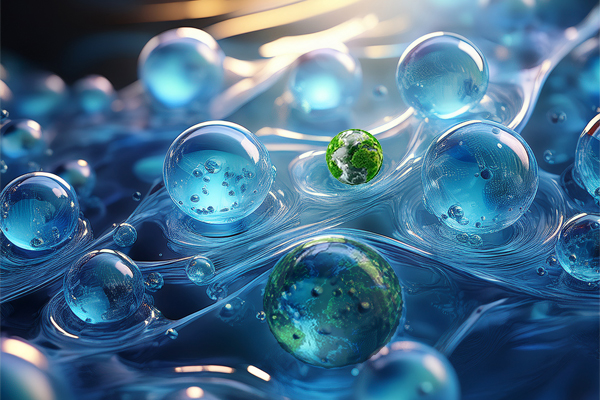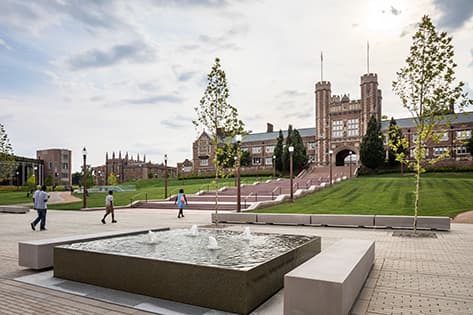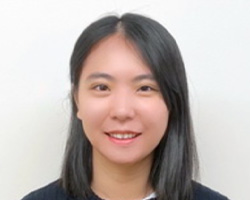A breakthrough in circular economy: Nanoparticles in hydrogels transform wastewater nutrients into fertilizer
Young-Shin Jun’s lab develops novel composite nanotechnology to promote circular nutrient economy

Excessive nutrients in wastewater can lead to detrimental discharges into natural water bodies, prompting harmful algal blooms with severe environmental and economic repercussions. To address this pressing issue, a team of engineers in the McKelvey School of Engineering at Washington University in St. Louis has developed an innovative solution. Their novel composite nanotechnology removes and recovers nutrients from wastewater, subsequently upcycling them as agricultural fertilizers or as biorefinery feedstocks, while simultaneously mitigating the occurrence of harmful algal blooms.
Young-Shin Jun, professor of energy, environmental & chemical engineering, and Minkyoung Jung, a doctoral student in her lab, created novel mineral-hydrogel composites that can remove and recover ammonium and phosphate from wastewater. These composites are embedded with nanoscale struvite and calcium phosphate mineral seeds, which significantly reduce ammonia and phosphate concentrations in wastewater by up to 60% and 91%, respectively. This reduction curbs algal growth and the associated toxins. This technology’s potential impact is underscored by a 2000 report from the U.S. National Oceanic and Atmospheric Administration, which estimated annual economic losses from harmful algal blooms in U.S. coastal waters to be between $33.9 million and $81.6 million.
Results of the research were published online May 29, 2025, in a special issue of Environmental Science & Technology “Advancing a Circular Economy.”
Like the moisture-absorbing gel in the core of disposable diapers, the hydrogel can soak up and repurpose excess nutrients. For their sustainable solution, Jun’s team used nature both as a model and for a beneficiary of its method.
“We designed these hydrogel composites to recover ammonia and phosphate, essential nutrients whose overabundance causes algal bloom,” Jun said. “Ammonia synthesis is energy-intensive, and phosphorus resources are dwindling. Our mineral-hydrogel composites allow us to harvest these nutrients from wastewater and repurpose them as fertilizers and feedstock for biorefineries.”
The process uses nanoparticle nucleation – the initial step in forming a solid phase in an aqueous system, similar to sugar crystals forming on a string to make rock candy. To facilitate that process, Jun’s team planted ultra-small mineral seeds in the hydrogel that were created from calcium phosphate and struvite, a mineral composed of magnesium, ammonium and phosphate that binds with calcium and other cations and ions. The ammonia and phosphate bind to the seeds and bulk up the hydrogel. During the process, the average particle sizes of the hydrogel increased from 6.12 nanometers to 14.8 nanometers.
Their approach addresses three significant challenges of conventional nutrient removal: inefficient collection in traditional methods, balancing the removal of both ammonia and phosphate and maintaining consistent removal efficiency in complex water conditions. This method achieves exceptionally low nutrient levels, effectively preventing harmful algal blooms.
Jun highlighted the scalability of the process, with successful trials conducted on up to 20 liters of fluid. The lab is now scaling up to 200 liters.
“This demonstrates the practical application potential of our fundamental scientific research, showing a viable path from the laboratory to everyday technology,” Jun said. “This pioneering work represents a significant advancement in environmental engineering, turning a waste problem into a valuable resource and exemplifying sustainability in action.”
Jun worked with WashU’s Office of Technology Management to patent the mineral hydrogel technology.
Jung M, Wang Y, Ilavsky J, Tang Y, Jun Y-S. Molecular insights into novel struvite-hydrogel composites for simultaneous ammonia and phosphate removal. Environmental Science & Technology, online May 29, 2025. https://pubs.acs.org/doi/10.1021/acs.est.4c11700
Funding for this research was provided by the U.S. Environmental Protection Agency and the U.S. Department of Energy.





